Unit - 1
Engineering Economics, Demand and Supply
Definition
Economics is described due to the fact the technological know-how that offers with the assembly, distribution and intake of merchandise and offerings. Economics, which developed with inside the nineteenth century, has emerge as one of the maximum essential research of our time. From small stores to countries, economics performs an essential function with inside the green operation of both. Businesses can't thrive without making use of the standards of economics. Economics studies are huge and diverse. The nature and scope of economics relies upon at the interplay of financial marketers and consequently the mechanics of the financial system. Let's examine the character and scope of economics in depth.
The nature of economics
The nature of economics offers with the query of whether or not economics falls into the class of technological know-how or art. While numerous economists are arguing in desire of technological know-how, different economists reserve art.
Economics as science
To recollect something as technological know-how, can we first want to realize what technological know-how is? Science offers with systematic research of causality. In technological know-how, records and numbers are amassed and systematically analyzed to attain unique conclusions. For those attributes, economics may be taken into consideration technological know-how. However, economics is handled as a technological know-how because of the following characteristics: It includes a scientific series of records and numbers. Like technological know-how, it's far primarily based totally at the components of concept and regulation. We are coping with causality. These factors show that the character of economics correlates with technological know-how. Like technological know-how, numerous financial theories are primarily based totally on logical reasoning.
Economics as an art
It is stated that "information is technological know-how and movement is art." Economic concept is used to clear up numerous financial troubles in society. Therefore, it may be inferred that now no longer most effective social technological know-how however additionally economics is an art.
Scope of economics
Economists use one-of-a-kind financial theories to clear up one-of-a-kind financial troubles in society. Its applicability could be very vast. From small agencies to multinational corporations, financial regulation is involved. The scope of economics may be understood in subheadings: microeconomics and macroeconomics. Let's give an explanation for those in detail.
Microeconomics
Microeconomics examines man or woman financial activities, industries, and their interactions. It has the subsequent features.
Elasticity: Determines the charge of alternate withinside the ratio of 1 variable to another. For example, the earnings elasticity of demand, the fee elasticity of demand, the fee elasticity of supply.
Production concept: Includes green conversion from enter to output. For example, packaging, shipping, storage, manufacturing.
Production cost: With the assist of this concept, the fee of an item is evaluated via way of means of the fee of a resource.
Monopoly: Under this concept, the prevalence of an unmarried entity is studied in a selected field.
Oligopoly: It corresponds to the domination of small entities withinside the market.
Macroeconomics
It's a take a look at of the financial system as a whole. We describe an extensive variety of aggregates and their interactions "top-down". Macroeconomics has the subsequent characteristics.
Growth: Study the elements that designate financial growth, inclusive of the country's growth in according to capita manufacturing over the lengthy term.
Business Cycle: This concept emerged after the best Depression of the 1930s. It advocates that significant banks and governments increase economic and financial regulations and reveal output in the course of the commercial enterprise cycle.
Unemployment charge: Measured via way of means of the unemployment charge. This is resulting from loads of elements, which includes growing wages and shortage of vacancies.
Inflation and Deflation: Inflation responds to growing commodity prices, and deflation responds to falling commodity prices. These signs are beneficial for assessing the financial state of affairs of a country.
Basic problems of an economy
Problem 1. What to produce and in what quantity?
The first significant problem of the financial system is determining which items and offerings to supply and in what quantity. This consists of the allocation of scarce sources associated with the composition of overall manufacturing withinside the financial system. Due to the dearth of sources, society has to determine what merchandise to supply, inclusive of wheat, cloth, roads, televisions, power and buildings.
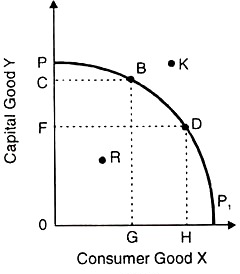
Once the nature of the product to be produced is determined, the quantity is determined. Tonnage of wheat, number of televisions, millions of kilowatts of electricity, number of buildings, etc. Due to the lack of economic resources, the question of the nature and quantity of goods should be determined based on: Social priorities or preferences.
If society prioritizes the production of more consumer goods than it does now, it will be less in the future. A high priority for capital goods means less consumer goods now and in the future. However, due to lack of resources, if one product is mass-produced, another product must be mass-produced.
This problem can also be explained using a productivity curve, as shown in Figure.
Suppose the economy produces capital goods and consumer goods. In determining the total output of an economy, society must choose that combination of capital and consumer goods that is in harmony with its resources.
The combination R inside the productivity curve PP1 is not selectable as it reflects the economic inefficiency of the system in the form of resource unemployment. Nor is it possible to select a combination R that is outside the scope of society's current productivity. Society lacks the resources to create this combination of capital and consumer goods.
Therefore, you should choose from combinations Â, E, or D that give you the highest level of satisfaction. If society decides to have more capital goods, it chooses combination B. If you need more consumer goods, choose Combination D.
Problem # 2. How to produce these products?
The next fundamental issue of the economy is determining the technology and methods used to produce the goods needed. This issue depends primarily on the availability of resources within the economy.
If you have a lot of land, it may be extensive farming. If you are short on land, you can use intensive tillage methods. If you have a large workforce, you may use labor-intensive technology. On the other hand, in the case of labor shortage, capital-intensive methods may be used.
The technology used also depends on the type and quantity of products produced. Producing capital goods and large-scale products requires complex and expensive machinery and technology. Simple consumer goods and small products, on the other hand, require small, inexpensive machines and relatively simple technology.
In addition, it is necessary to decide what goods and services will be produced in the public sector and what goods and services will be produced in the private sector. However, when choosing from different production methods, it is necessary to adopt methods that bring about efficient allocation of resources and improve the productivity of the economy as a whole.
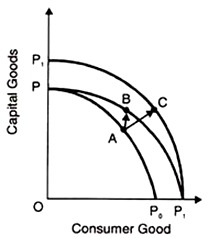
Suppose the economy is producing a certain amount of consumer and capital goods at point A on the PP curve in Figure. Considering the supply of elements, adopting new production technology will improve the production efficiency of the economy. As a result, the PP0 curve shifts outward to P1P1.
This will produce more consumer and capital gods from point A on the PP0 curve to point С on the PP, creating a new productivity curve and the economy will produce more of both commodities from point A. Go to.
Problem # 3. For whom is the product produced?
The third basic issue to be decided is the distribution of goods among the members of society. Basic consumer goods and necessities, luxury comfort, and distribution between households are based on the distribution of national income.
Anyone who has the means to buy goods may have it at that time. The rich make up the majority of luxury goods, and the poor may have more of the basic consumer goods they need. This problem is shown in Figure. Here, the productivity curve PP shows the combination of luxury goods and necessities.
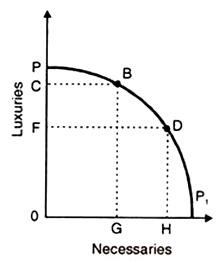
At the point В of the PP curve, the economy has created a lot of luxury for the wealthy and less needed for the art. On the other hand, at point D, we are increasing the OH required for the poor and decreasing the need for the rich.
Problem # 4. How efficiently are your resources being used?
This is one of the key fundamental issues of the economy. Because, after making the previous three decisions, society needs to make sure that its resources are being fully utilized. When economic resources are wasted, we must find ways and means to make full use of them.
If the laziness of resources such as human resources, land and capital is due to male allocation, society needs to adopt such financial, financial or physical measures to remedy this. This is shown in Figure. Here, the productivity curve PP reflects the idle resources in the economy at point A, and the productivity curve P1P1 reflects the full utilization of resources at point  or C.
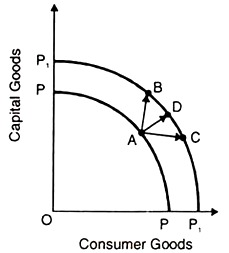
Society produces more capital goods at point Â, more consumer goods at point C, or full employment at point D in an economy where available resources are fully utilized. Decide whether to produce both at the level. It is characterized by technical efficiency or full employment.
To keep it at this level, the economy must constantly increase production of some goods and services by giving up on others.
Problem # 5. Is the economy growing?
The last and most important issue is determining whether the economy is growing or stagnant over time. If the economy is stagnant at any point within the productivity curve, as shown in Figure, then you need to move to the productivity curve PP. This causes the economy to produce more consumer and capital goods.
Economic growth occurs through higher capital formation rates, which consist of replacing existing capital goods with new and more productive ones, either by adopting more efficient production technologies or through innovation.
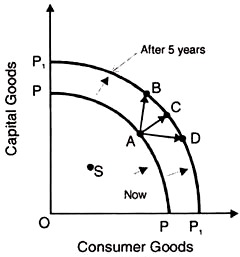
This shifts the productivity curve outward from PP to P1P1. The economy moves from point A on the P1P1 curve to В or С or D, for example after 5 years. Point С represents a situation in which both consumer and capital goods are mass-produced in the economy. Economic growth allows the economy to have more of both commodities.
Micro Economics
Microeconomics (Greek prefix micro-meaning "small") is a department of economics that research the conduct of people and groups in making choices approximately the allocation of scarce assets. "Interaction among those people and groups"
Microeconomics is a observe of character, family, and company conduct in choice making and aid allocation. It usually applies to the marketplace for items and offerings and offers with non-public and economic problems.
Meaning
Microeconomics is a observe of character, family, and company conduct in choice making and aid allocation. It usually applies to the marketplace for items and offerings and offers with non-public and economic problems.
Microeconomics is a department of economics that research the conduct of people and groups in making choices approximately the allocation of scarce assets and their interactions among people and groups.
This is taken into consideration to be fundamental economics. Microeconomics may be described as a discipline of financial evaluation that research the financial conduct of character units, which include people, precise households, or precise companies.
The production of goods and services is based on the allocation of scarce resources.
Efficient Goods Distribution – It investigates issues related to
(a) product pricing,
(b) factor pricing, and
(c) economic welfare.
a. Product pricing – Includes product pricing under monopoly, perfect competition, etc., taking into account supply, demand, production costs, and more.
b. Factor Pricing-Prices factor inputs such as land, labor, capital, and organization in the form of rent, wages, interest, and profits, respectively.
c. Economic Welfare – It includes research on the greatest interests for producers and the greatest interests for consumers.
Macroeconomics
The term "macro" was first utilized in economics by Frisch in 1933. However, it came from the 16th and 17th century mercantilists as a methodological approach to economic problems. They were interested in the entire economic system. In the 18th century
Physiocrats adopted it in the table economy, showing a "cycle of wealth" (i.e., net production) among the three classes represented by the peasant, landowner, and barren classes.
Malthus, Sismondi and Marx within the 19th century addressed macroeconomic issues. Walrus, Wicksell and Fisher contributed modernly to the development of pre-Keynes macroeconomic analysis.
Certain economists such as Cassel, Marshall, Pigoubian, Robertson, Hayek, and Hortley developed the Quantity Theory of Money and General Price Theory in the decade following World War I. However, Keynes eventually developed a general theory of income, output, and employment. I have credibility in the wake of the Great Depression.
Economics is the science of producing, exchanging, and consuming various commodities in the economic system. It is a rare resource that can reduce the abundance of human welfare. The central focus of economics is the choice between resource depletion and its alternative uses. The word "economics" comes from the Greek words "oikos" (house) and nemein (manage), which means to manage a household with limited funds.
Macroeconomics is a crucial concept that considers the entire country and works for the welfare of the economy.
1. Business cycle analysis
Timing of economic fluctuations helps prevent or prepare for financial crises and long-term negative situations.
2. Formulation of economic policy
The fiscal and monetary policy system relies entirely on an extensive analysis of the country's macroeconomic situation.
3. Reduce the effects of inflation and deflation
Macroeconomics is primarily aimed at helping governments and financial institutions prepare for a country's economic stability.
4. Promote material welfare
This economic stream provides a broader perspective on social or national issues. Those who want to contribute to the welfare of society need to study macroeconomics.
5. Regulate the economic system
It continues to guarantee or check the proper functioning and actual position of the country's economy.
6. Solve economic problems
Macroeconomic theory and problem analysis help economists and governments understand the causes and possible solutions to such macro-level problems.
7. Economic development
By utilizing macroeconomic data to respond to various economic conditions, the door to national growth will be opened.
Key takeaways:
- Economics is defined because the science that deals with the assembly, distribution and consumption of products and services.
- The nature of economics deals with the question of whether economics falls into the category of science or art.
- Science deals with systematic studies of causality. In science, facts and numbers are collected and systematically analyzed to reach specific conclusions.
- It is said that "knowledge is science and action is art." Economic theory is used to solve various economic problems in society. Therefore, it can be inferred that not only social science but also economics is an art.
- Economists use different economic theories to solve different economic problems in society.
- Microeconomics examines individual economic activities, industries, and their interactions.
- Basic problems of an economy.
- The first central issue of the economy is deciding which goods and services to produce and in what quantity.
- The next fundamental issue of the economy is determining the technology and methods used to produce the goods needed.
- The third basic issue to be decided is the distribution of goods among the members of society
- This is one of the key fundamental issues of the economy. Because, after making the previous three decisions, society needs to make sure that its resources are being fully utilized. When economic resources are wasted, we must find ways and means to make full use of them.
- The last and most important issue is determining whether the economy is growing or stagnant over time.
8. Microeconomics studies individual and business decisions, while macroeconomics analyzes decisions made by countries and governments.
9. Microeconomics has been a bottom-up approach, focusing on supply and demand, and other forces that determine price levels.
10. Macroeconomics takes a top-down approach, looks at the economy as a whole, and tries to determine its course and nature.
Demand:
It is one of the determinants of business as it can affect business growth and economic growth. Demand is a factor that enables businesses to generate innovative ideas and think proactively to increase market demand. Therefore, understanding demand is very important to your business.
Meaning of demand:
Demand can be defined as an economic principle related to a consumer's desire to purchase a product or service and their willingness to pay for the purchase of a particular product or service.
The definition of demand is the consumer's desire to buy goods and services and the willingness to pay the price required to buy them. Demand is one of the major components of the economy. When we talk about the demand for goods and services, we talk about not only the single quantity requested, but also the complete demand curve.
Demand for products and services is affected by fluctuations in product prices. According to the law of demand, as the price of a product rises, the demand for the product decreases. All other factors remain constant and vice versa.
As a result, companies spend enormous amounts of money determining the demand for products and services in the market. How many items can be sold at a particular price?
Companies need to accurately estimate market demand. A false estimate can leave money on the table if demand is undervalued and can lead to a loss of invested capital if demand is overvalued. Demand is the fuel to keep your business and economy running. If there is no demand in the market, no company wants to produce anything.
There is a close relationship between supply and demand. Consumers try to pay as little as possible for the goods and services they want to buy, while suppliers want to make as much profit as possible. Therefore, the demand for goods and services is directly proportional to the prices of goods and services, and companies need to correctly price goods and services so that they are available to both suppliers and consumers.
If the cost of a product is too high, the demand will decrease as a result of the supplier not selling well, and customers will move to competitors who offer similar products at affordable prices. In contrast, suppliers can attract a large number of customers by keeping the prices of their products and services low. Still, low prices cannot cover the costs of the supplier, so despite the large number of customers, the supplier suffers losses or small profits.
Demand Function:
The demand function represents the relationship between the quantity required for a product (dependent variable) and the price of the product (independent variable).
Assume that the quantity required for goods X is Dx, depends only on price Px, and the other factors are constant. It can be mathematically expressed as:
Dx = f (Px)
However, the quantitative relationship between Dx and Px is expressed as follows.
Dx = a – bPx
Where a (intercept) and b (relationship between Dx and Px) are constants.
Types of Demand Function
2 types of demand function are:
- Linear demand function
- Non linear demand function
Linear demand function
In a linear demand function, the slope of the demand curve remains constant throughout its length. The linear demand equation is mathematically expressed as:
Dx = a – bPx
In this equation, a represents the aggregate demand at zero price.
b = Slope or relationship between Dx and Px
b can also be represented by the change in Dx with respect to the change in Px.
If you know the values of a and b, you can calculate the demand for goods at any price using the formula above.
For example, let us assume a = 50, b = 2.5, and Px= 10:
Demand function is:
Dx = 50 – 2.5 (Px)
Therefore, Dx = 50 – 2.5 (10)
or Dx= 25 unit
The demand schedule for the above function is given in Table
QUANTITY DEMANDED OF | PRICE LEVELS OF |
5 | 18 |
10 | 16 |
15 | 14 |
20 | 12 |
When the demand schedule is plotted on a graph, it produces a linear demand curve, which is shown in Figure below.
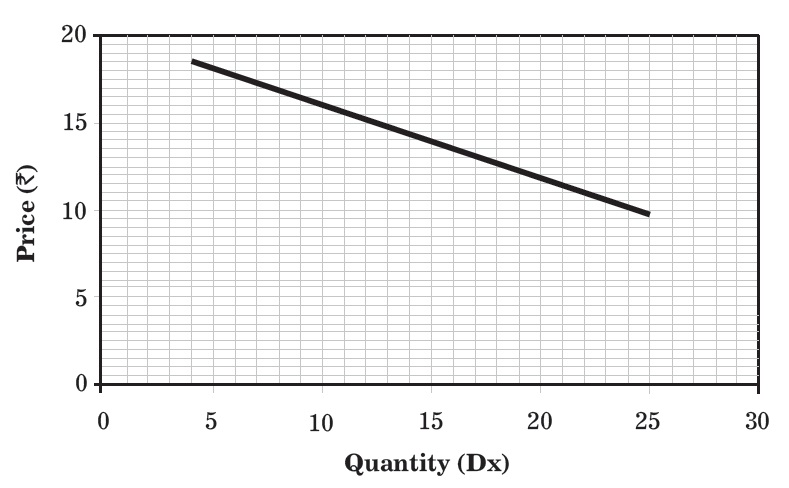
Demand Curve in Linear Demand Function
Non-linear demand function
In a non-linear or curved demand function, the slope of the demand curve (ΔP / ΔQ) changes along the demand curve. Instead of a demand line, a non-linear demand function produces a demand curve.
The nonlinear demand equation is mathematically expressed as:
Dx = a (Px) -2
Or a rectangular hyperbola of the form:
Dx = a / Px + c
Where a, b, c> 0
The price index of the non-linear demand function –b refers to the coefficient of price elasticity of demand.
Figure, represents a non-linear demand function:
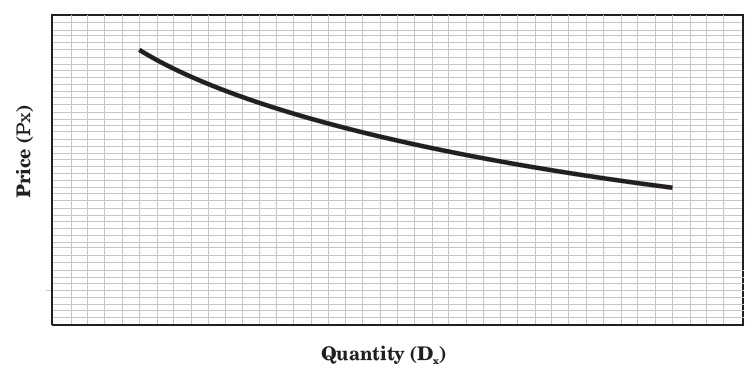
Non linear Demand Function
Law of demand and its exceptions
The law of demand states that all other factors remain constant or equal, an increase in the price causes a decrease in the quantity demanded and a decrease in goods or services price leads to increase in the quantity demanded. Thus it expresses an inverse relationship between price and demand.
For example, at Rs 70 per kg consumer may demand 2 kg of apple. On the other hand, the price rises to 100/- per kg then he may demand 1 kg of apple
Assumption of law of demand
- No change in the income
- No change in size population
- No change in price of related goods
- No change in consumers taste, preferences, etc
- No expectation of a price change in future
- No change in climate conditions
Given these assumption, the law of demand is explained in the below table –
Price(Rs) | Quantity demanded |
10 | 10 |
8 | 20 |
6 | 30 |
4 | 40 |
2 | 50 |
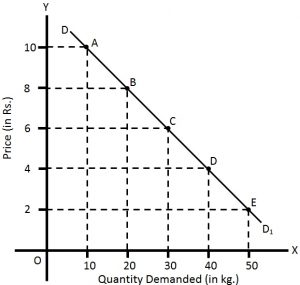
The above table shows that when the price of apple, is Rs. 10 per kg, 10 kg are demanded. If the price falls to Rs.8, the demand increases to 20 kg. Similarly, when the price declines to Rs 2, the demand increases to 50 kg. This indicates the inverse relation between price and demand.
Also, in the above figure the demand curve slopes downwards as the price decreases, the quantity demanded increases.
Exception of law of demand
Under the following circumstances, consumers buy more when the price of a commodity rises, and less when price falls which leads to upward sloping demand curve.
- Giffen goods
Giffen Goods is a concept introduced by Sir Robert Giffen. These products are inferior to luxury products. However, a unique feature of Giffen goods is that as prices rise, so does demand. And this feature is an exception to the law of demand.
The Irish potato famine is a classic example of the concept of Giffen goods. Potatoes are the staple food of Ireland. During the potato famine, when potato prices rose, people spent less on premium foods such as meat and bought more potatoes to stick to their diet. As the price of potatoes went up, so did the demand. This is a complete reversal of the law of demand.
b. Veblen goods
The second exception to the law of demand is the concept of Veblen goods. The Veblen goods are a concept named after the economist Thorstein Veblen, who introduced the theory of "exaggerated consumption". According to Veblen, there are certain products that increase in value as prices go up. When a product is expensive, its value and usefulness are perceived to be higher, and therefore the demand for that product increases.
And this mainly occurs in precious metals such as gold and diamonds, stones, and luxury cars such as Rolls-Royce. As the price of these items rises, so does the demand as they become status symbols.
c. Expectations for price fluctuations
In addition to Giffen and Veblen goods, another exception to the law of demand is the forecast of price fluctuations. The price of the product will rise and the product may become more expensive depending on the market conditions. In such cases, consumers may purchase more of these products before the price rises further. As a result, if prices go down or are expected to go down further, consumers may postpone their purchases to take advantage of the low prices.
For example, the price of onions has risen considerably these days. Consumers began to buy and store more onions for fear of further price increases, resulting in increased demand.
In addition, consumers may purchase and store products for fear of shortages. Therefore, even if the price of a product rises, the demand associated with it may increase as the product is taken off the shelf or no longer on the market.
d. Necessary products and services
Another exception to the law of demand is the required or basic merchandise. As prices go up, you'll continue to buy essentials such as medicine and basic staples such as sugar and salt. The prices of these products do not affect the associated demand.
e. Changes in income
Changes in income may change the demand for goods. Increasing household income can lead to more products being purchased, regardless of rising prices, which increases demand for products. Similarly, if your income goes down, you may postpone your purchase of the product, even if the price goes down. Therefore, changes in consumer income patterns can also be an exception to the law of demand.
Determinants of demand
Top 10 Determinants of Demand for an Economy
1-Price of goods or services
When the price of goods and services goes up, the demand for quantity goes down, and when the price of goods and services goes down, the demand for quantity goes up. Also known as the law of demand.
When the demand does not change even with the price change called inelastic demand, and when the quantitative demand changes more than the price change called elastic demand.
2 – Prices for alternative / complementary goods and services
Alternatives are products that meet the same needs. For example, peanut oil and sunflower oil, and tea and coffee are alternatives to each other, so higher prices for peanut oil can increase demand for sunflower oil. The reverse is also true.
Complementary goods are commodities that are consumed together, such as Car & Diesel and Tea & sugar, which increase the price of Car and decrease the demand for both Diesel & Car.
3-Buyer preferences and preferences
Product demand can change based on buyer preferences and preferences, and brand advertising plays an important role in changing buyer preferences and preferences. For example, we used to think that chocolate was primarily for children, but the advertising industry changed this notion by showing that chocolate is for everyone from children to the very elderly. ..
Similarly, they constantly come up with new trends in the market that affect their customers and ultimately affect the demand for their products.
4 – Buyer expectations for future prices of goods
When people expect the price of something to go up in the future, they tend to buy more of those products, which leads to an increase in demand for those products. For example, when people expect the price of gold to go up, they will buy more and more gold, and vice versa.
“The same thing happened in the 2015 housing bubble, when house prices were rising, but people were willing to buy homes when the process began to decline during the recession.
People weren't buying a home, even though home prices went down.
5 – Changes in buyers' real income or wealth
The purchasing power of a buyer depends on income and wealth. Demand for goods and services is much lower than in developed countries in undeveloped areas where jobs are not readily available and people earn less. Cities like New York, where many jobs are available, have good income and purchasing power, and demand for goods and services is high.
It is very easy to distinguish that luxury goods in cities with more jobs are always in high demand compared to cities with less employment opportunities. Consumption is based not only on income, but also on higher consumption of wealth and vice versa.
6-Buyer Expectations for Future Income and Wealth
Higher expectations for future income and wealth increase consumption, and lower expectations for future income decrease consumption.
For example, students who have completed higher education and are looking to get a job will start spending more than those with salaries who will retire in the next few years.
7 – Number of buyers
Increasing the number of buyers who are willing to buy goods and services will affect overall demand. Population has a big impact on demand. Population growth can be an ad hoc demand curve.
New buyers help increase quantity demand. In this case, the demand will change even if the price does not change.
8 – Government Policy
For many products, demand depends on government policy. For example, lower borrowing rates lead to increased demand for mortgages as people start buying homes as mortgage rates fall.
As another example, the US government has banned some models of Volkswagen due to pollution issues, so there is no demand for those models in the United States. Taxation also affects the demand for products. A tax increase will lead to higher product prices and lower demand for that product.
9 – Climate change
There are many products whose demand is seasonal or whose demand depends on the climate.
For example, the demand for winter clothes is high in the winter season and the demand for ice cream is high in the summer season. If winter is over and there is no demand for winter clothing companies to sell winter clothing at a discounted price, discount sales will be available at shops and malls after the end of the season. This discount offer helps sellers increase demand.
10 – Income distribution
Demand for luxury goods is high in areas where very wealthy people are staying, while demand for luxury goods is low in undeveloped areas where middle-income people are staying.
Elasticity of demand and its measurement (Simple numerical problems to be solved)
The elasticity of demand is an important variation on the concept of demand. You can classify the demand as Elastic, inelastic, or as single.
The elasticity of demand is the change in the quantity required due to price changes big. . An inelastic demand is one in which the change in quantity demanded due to a change in the price is small.
The formula used here for computing elasticity of demand is:
(Q1 – Q2) / (Q1 + Q2)/ (P1 – P2) / (P1 + P2)
If the formula creates an absolute value greater than 1, the demand is elastic. In other words, quantity changes faster than price. If the value is less than 1, demand is inelastic. In other words, quantity changes slower than price. If the number is equal to 1, elasticity of demand is unitary.
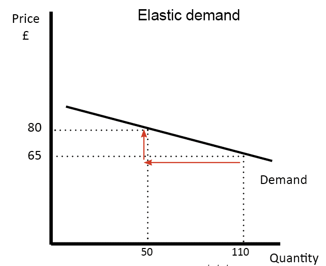
Elasticity of demand is illustrated in Figure. Note that a change in price results in a large change in quantity demanded. An example of products with an elastic demand is consumer durables. These are items that are purchased infrequently, like a washing machine or an automobile, and can be postponed if price rises. For example, automobile rebates have been very successful in increasing automobile sales by reducing price.
Close substitutes for a product affect the elasticity of demand. If another product can easily be substituted for your product, consumers will quickly switch to the other product if the price of your product rises or the price of the other product declines. For example, beef, pork and poultry are all meat products. The declining price of poultry in recent years has caused the consumption of poultry to increase, at the expense of beef and pork. So products with close substitutes tend to have elastic demand.
Inelastic Demand
In figure, note that change in price results in only a small change in required quantity. In other words, the amount respondent is not very sensitive to changes in price. Examples of these are necessities like food. And fuel. Consumers will not cut down on their food shop if food prices go up, even though changes in the types of food they buy. Also, consumers will not change the way they drive much behaviour if gasoline prices rise.
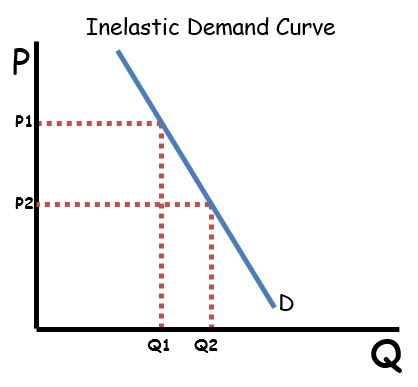
Unitary Elasticity
If the elasticity coefficient is equal to one, demand is unitarily elastic as shown in Figure. For example, a 10% quantity change divided by a 10% price change is one. This means that a 1% change in quantity occurs for every 1% change in price.
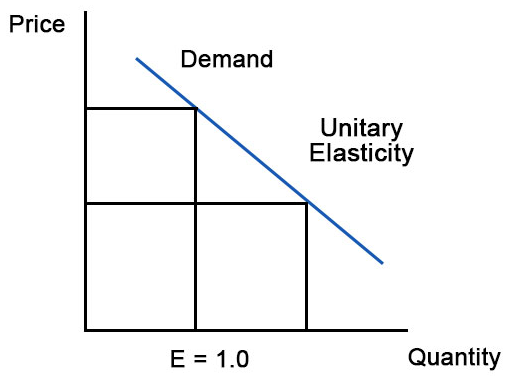
Elasticity can be calculated in two ways. First, it is as the mean over a range of demand functions, in which case it is called the arc elasticity.
Arc price elasticity can be calculated using the following midpoint formula:
Demand arc price elasticity
The formula for calculating the arc elasticity can be expressed as:
Arc elasticity calculation formula
Where Ep is the amount of arc elasticity required for the price.
P1 and Q1 are the original price and quantity,
P2 and Q2 are the final price and quantity,
∆P is an absolute change in price,
∆Q is the absolute change in quantity.
Note that Ep is always a pure number such as 1, 1/2, 1/4, etc., as it is a rate of change of 2 percent.
The demand curve slopes downward, so either ΔP or ΔQ is negative. Therefore, the calculated value of elasticity has a negative sign.
The arc price elasticity can be calculated based on the midpoint formula. If Ep> 1, the demand is said to be elastic. If the demand for Ep = 1 is inelastic and the demand for Ep <1 is inelastic. Consider the following example.
Example 1:
Suppose your income is constant at rupees. 3,000 a year, the current price of the goods is rupees. The current demand for 10 is 125 units per month. Now the price drops to rupees. A large quantity of 150 units may be required in 9 and a month. What is the arc price elasticity in this range of the demand curve?
Solution:
Substituting the value into the arc elasticity equation gives:
What is the importance of the calculated modulus of elasticity? This shows that for every 1% decrease in price in the relevant range of the demand curve, the quantity increases by 1.73%. A negative value of the elasticity coefficient of demand means that as P decreases, the quantity Q increases, and vice versa.
The advantage of this calculation method is that it is a more accurate measurement than using the first or last P and Q bases. This is because when dealing with the range of price fluctuations, it is always better to get an indicator that reflects the average consumer responsiveness.
For discrete (large) or one-time P changes, use the above equation. However, as a special case of arc elasticity, we may use the concept of point elasticity. For small (or continuous) changes in P and Q, Ep can be calculated for points on the demand function, called point price elasticity.
You have the sole authority to sell sandwiches in Eden Gardens during a test Match. Each costs 50 p. (including all relevant costs such as that of your labour).
From previous experience your best estimate of the demand is the following:
Price |
90p. 95p. Re.1.00 Rs.1.05 Rs.1.10 Rs.1.15 Rs.120 |
Sales (per day) |
2400 2200 2000 1800 1600 1400 1200
|
Calculate the elasticity of demand on this demand schedule around the price of Re. 1. Explain precisely the concept of elasticity you use.
Solution:
Elasticity of demand around a price of Re. 1:
Elasticity of demand = Proportionate change in quantity demanded/Proportionate change in price
When price increases from Re. 1 to Rs. 1.05, proportionate increase is 5%. At Rs. 1.05 proportionate decrease in quantity demanded, i.e., from 2000 to 1800 is of 10%.
Demand Forecasting - Meaning
Demand forecasting is the process of estimating future customer demand for a defined period of time using historical data and other information.
Good demand forecasting gives companies valuable information about their current and other market potential, allowing managers to make informed decisions about pricing, business growth strategies, and market potential.
This is a method for estimating the expected demand for future products or services. It is based on an analysis of past demand for that product or service in current market conditions. Demand forecasts should be evidence-based and take into account the facts and events associated with the forecasts.
So, simply put, after gathering information about different aspects of the market and demand based on the past, attempts may be made to estimate future demand. This concept is called demand forecasting.
For example, suppose you sell 200, 250, and 300 units of Product X in January, February, and March, respectively. With this, it can be said that there is a demand for about 250 units. If market conditions do not change, for product X in April.
Key takeaways:
- It is one of the determinants of business as it can affect business growth and economic growth.
- Demand can be defined as an economic principle related to a consumer's desire to purchase a product or service and their willingness to pay for the purchase of a particular product or service.
- The demand function represents the relationship between the quantity required for a product (dependent variable) and the price of the product (independent variable).
- In a linear demand function, the slope of the demand curve remains constant throughout its length.
- The law of demand states that all other factors remain constant or equal, an increase in the price causes a decrease in the quantity demanded and a decrease in goods or services price leads to increase in the quantity demanded.
- Giffen goods are those products where the demand increases with the increase in price. For example, necessities products like rice, wheat. Lower incomes group will spend less on superior foods (like meat) to buy more rice, wheat etc.
- When the price of goods and services goes up, the demand for quantity goes down, and when the price of goods and services goes down, the demand for quantity goes up. Also known as the law of demand.
- Product demand can change based on buyer preferences and preferences, and brand advertising plays an important role in changing buyer preferences and preferences.
- Higher expectations for future income and wealth increase consumption, and lower expectations for future income decrease consumption.
- The elasticity of demand is an important variation on the concept of demand. You can classify the demand as Elastic, inelastic, or as single.
- Demand forecasting is the process of estimating future customer demand for a defined period of time using historical data and other information.
Meaning of supply:
Supply is a financial time period that refers to the amount of a selected services or products that a dealer is inclined to provide to a client at a selected fee stage over a selected length of time.
If the fee of the product is low, the deliver may be low. The better the really well worth of the merchandise, the top the availability. This makes feel due to the fact corporations are searching out earnings with inside the marketplace. They are probable to provide merchandise which has the capacity to generate better fees and earnings than otherwise.
Law of supply and its exceptions:
Law of deliver states that every one element being constant, supplier deliver extra withinside the growing fee and deliver much less while the fee decreases.
Definition “Other matters ultimate unchanged, the delivery of a commodity rises i.e., expands with an upward thrust in its fee and falls i.e., contracts with a fall in its fee.
Assumption
1. No extrude in income
2. No extrude in approach of manufacturing
3. No extrude in shipping cost
4. The fee of different items continue to be constant
5. No extrude in authority’s policies
6. No hypothesis approximately destiny adjustments withinside the fee of the product
7. Fixed scale of manufacturing Explanation of the regulation Law of deliver defined with the assist of deliver agenda and deliver curve
Supply schedule
Supply schedule is the tabular illustration of fee and amount provided with the aid of using the vendor.
Price (in Rs.) | Quantity supplied (in kg) |
10 | 1 |
20 | 2 |
30 | 3 |
40 | 4 |
50 | 5 |
When the fee become Rs 10, amount provided become 1kg. When the fee began out 3ising from Rs 20 to 50 to forty so on, the amount provided with the aid of using the vendor extended from 2kg, three kg to 5kg respectively.
Thus, the above desk indicates wonderful relation among fee and amount.
Supply curve
The deliver curve is a graphical illustration of a deliver agenda.
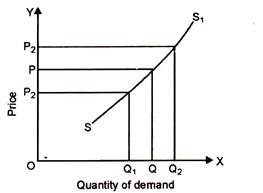
In the above figure, OX axis indicates amount of call for and OY axis indicates fee. When the fee become at OP, dealer become presenting OQ amount. When the fee will increase from OP to OP2 after which deliver additionally will increase from OQ to OQ2. Similarly, if fee decreases from OP to OP1, then deliver additionally decreases from OQ to OQ1.
In the above figure, we are able to see deliver curve is sloping upward. The marketplace deliver rises with the upward thrust in fee.
Limitation of law of supply
- Price expectation in future- the seller expects the price to rise in future, and then he will sell less. In case the price will fall in future, then the seller will sell more which is against law of supply
- Fear of out of fashion – if the seller expects that the goods will be outdated in future, then he will sell the goods at low price.
- Stock clearance sale – when the seller wants to store new stock, then he will sell old stock at discounted price.
- Perishable goods – these goods have short life time. The seller will sell the goods at any price.
Exceptions of law of supply:
The law of supply is not a universal principle that applies in all situations. In fact, there are many important exceptions to the law of supply. Here are some exceptions to the law of supply:
- Business changes
- Exclusive
- Competition
- Perishables
- Law to limit quantity
- Agricultural products
- Art and auction products
- Outdated products
- Economic slowdown
- Immediate request for funds
1. Business changes
The seller may plan to enter a whole new business by withdrawing from the current business. Therefore, when the current business is on the verge of closure, the seller can sell his goods at a lower price to get rid of them. Therefore, the law of supply is not obeyed here either.
2. Exclusive
If a small number of producers control the supply in the market, the law of supply may not work. For example, in the case of a monopoly (single seller), the high price of a product does not necessarily mean that it will provide a large supply. Exclusive market management allows you to set market prices based on market demand.
3. Competition
Other market structures such as oligopoly and monopoly competition may face more competition and therefore propose to sell more quantities at lower prices and the law of supply. I deny it.
4. Perishables
For perishables, the supplier proposes to sell more quantities at lower prices to avoid losses due to product damage.
5. Law to limit quantity
A supplier cannot offer to sell a larger quantity at a higher price if the government imposes some restrictions on the quantity of goods produced or the upper limit of the price at which the goods are sold on the market.
6. Agricultural products
Agricultural production cannot be increased beyond a certain limit, so high prices cannot increase supply beyond this limit. Producers cannot offer any more quantities.
7. Art and auction products
The supply of such goods cannot be easily increased or decreased according to its demand. Therefore, even if the price soars, it is difficult to offer a larger quantity.
8. Outdated products
When a product is in fashion, the seller can sell it at a high price. However, there are some products that have become obsolete and are no longer in fashion. Such items are sold at a low price by the seller to settle these items.
9. Economic slowdown
Businesses go through different phases and sellers need to adapt to these business-related changes. During times of economic downturn, sellers may not enjoy the benefits of price increases, so during these difficult times, sell products without witnessing price increases to recover costs. Increase. Therefore, the law of supply does not apply in this case either.
10. Immediate request for funds
Sellers may face a time when they need money soon. In this situation, he may supply goods on the market even at lower prices.
Determinants of supply
Determinants of supply are as follows.
- Price of production factor (C)
An engine supply curve is a curve that represents the lowest price a producer wants to supply a product to.
As the price of the factor of production goes up, so does the lowest price that the producer wants to offer. As a result, the supply decreases and the supply curve shift to the left.
For example, cocoa tree seeds are used to make chocolate. As the price of cocoa beans goes up, so does the cost of making chocolate. As a result, supply is reduced.
2. Supply determinants: Technology (T)
Technology refers to the methodology of using resources to produce goods. If you find a more efficient technology and use it to manufacture your product, your manufacturing costs will go down.
As a result, supply increases and the supply curve shift to the right. Improvements in technology can also help reduce production costs and increase profits.
3. Related product prices (Pn)
The prices of goods and substitutes produced by a company affect the supply of related products. This means that if the price of another good that a company can produce rises, the company will produce more and less than what it was previously producing.
Goods that can be produced using the same resources are called substitutes in the production process.
For example, if the price of mung bean is relatively high, the land used to grow corn can be used to grow mung bean. After that, the supply of corn will decrease.
4. Producer's expectations (example)
Changes in producer expectations affect the current supply of products. It is not clear how price expectations will affect current supply, as they depend on the nature of the product.
For example, producers are expanding their supply, believing that future prices for industrial products will be higher.
Forecasting changes in factors that affect future profitability will affect current supply. Expectations for business taxes and import restrictions are examples.
5. Number of producers in the market (N)
The number of suppliers in the market also affects the supply of the market. As the number of suppliers increases, the supply increases, and when the number of suppliers decreases, the supply decreases.
6. Government Policy (G)
Government policy can be pointed out as a determinant of supply. Various government regulations, taxes and production subsidies also affect supply. For example, taxes on goods increase the marginal cost of production. Production subsidies, on the other hand, reduce marginal costs. Therefore, the minimum price at which the goods are supplied also increases or decreases.
7. Supply determinants: Other factors (O)
Among them, changes in supply due to the influence of nature and the Internet are pointed out. Disasters such as plagues, droughts and floods cause supply changes.
Elasticity of supply
Supply elasticity establishes a quantitative relationship between the supply of goods and their prices. Therefore, the concept of elasticity can be used to represent the numerical changes in supply as the price of goods changes. Note that elasticity can also be calculated for other supply determinants.
The price elasticity of supply is the ratio of the percentage change in the price to the percentage change in quantity supplied of a commodity.
Es= [(Δq/q) ×100] ÷ [(Δp/p) ×100] = (Δq/q) ÷ (Δp/p)
Δq= The change in quantity supplied
q= The quantity supplied
Δp= The change in price
p= The price
Elasticity from a Supply Curve
Along with the method mentioned above, there are two more ways to calculate the price elasticity of supply, both of which make use of the supply curve. We can either calculate the elasticity at a specific point on the supply curve, known as point elasticity or between two prices, known as arc-elasticity.
The formula for calculating the point elasticity of supply is:
Es= (dq/dp) ×(p/q)
Here dq/dp is the slope of the supply curve.
The formula for calculating the arc-elasticity of supply is:
Es= [(q1 – q2)/ (q1 + q2)] × [(p1 + p2)/ (p1 – p2)]
Types of Elasticity of supply
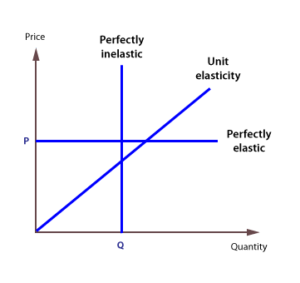
- Perfectly inelastic supply
A carrier or items, regardless of the fee, may be a very inelastic deliver if a positive amount may be provided. The elasticity of the delivery of such offerings and items is 0. An absolutely inelastic deliver curve is an immediately line parallel to the Y axis. This represents the truth that deliver stays the equal no matter fee.
2. Unitary Elastic
For a product with unit elasticity of deliver, the extrade with inside the delivery of the product is precisely similar to the extrade in its fee. In different words, adjustments in each the fee and deliver of products are proportional and same to every different. To factor out, the pliancy of the deliver in such instances is same to 1. In addition, an unmarried elastic deliver curve passes thru the origin.
3. Perfectly Elastic demand
A commodity with a superbly elastic deliver has an endless elasticity. In this sort of case the delivery will become 0 with even a moderate fall with inside the fee and will become endless with a moderate upward thrust in fee. This is indicative of the truth that the providers of this sort of commodity are inclined to deliver any amount of the commodity at a better fee. A flawlessly elastic deliver curve is an immediately line parallel to the X-axis.
Determination of market equilibrium (Simple numerical problems to be solved)
Perfect competition is a market structure in which each company is a price taker and the price is determined by the market power of supply and demand. We know that equilibrium refers to the state of balance. In other words, under perfect competition, the market equilibrium is determined when the market demand is equal to the market supply.
Recall the concept of market supply and demand.
(I) Market demand is the sum of the demand for goods by all buyers in the market. The curve slopes downward due to the operation of the law of demand.
(Ii) Market supply is the sum of the supply of goods by all producers in the market. The curve slopes upward due to the operation of the law of supply.
Both supply and demand in the market act as reaction forces that move in opposite directions. Market equilibrium is determined when the demand for goods equals the supply. The price determined in response to the market equilibrium is called the equilibrium price, and the corresponding quantity is called the equilibrium quantity.
As you can see in Table and Figure, both buyers and sellers are negotiating to buy or sell chocolate. Both offer different prices.
Price of Chocolate(Rs.) | Market Demand (units) of chocolate | Market Supply (units) of chocolate | Shortage (-) or Advertisements Surplus(+) | Remarks |
2 | 100 | 20 | B80 | Excess Demand |
4 | 80 | 40 | (-)40 | (As Market demand>Market Supply) |
6 | 60 | 60 | 0 | Equilibrium level (as Market demand=Market supply) |
8 | 40 | 80 | (+)40 | Excess supply |
10 | 20 | 100 | (+)80 | (As Market supply>Market Demand) |
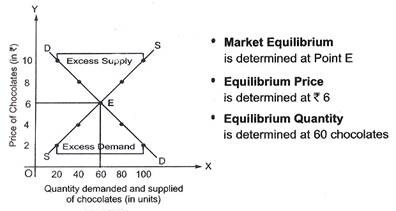
Buyers will want to pay as low as possible and sellers will want to charge as high as possible. However, market equilibrium is determined only if both agree on a common price and a common quantity at that price.
With the rise in price from Rs. 2 to Rs. 4, market demand will decrease from 100 to 80 chocolates, market supply will increase from 20 to 40 chocolates. The market demand curve DD and the market supply curve SS intersect at point E, which is the market equilibrium. At this point, f 6 is determined as the equilibrium price and 60 chocolates are determined as the equilibrium quantity. This equilibrium price and quantity tends to persist.
Important points regarding market equilibrium under perfect competition:
i. Each company is a price taker, and the industry is a price taker.
Ii. Each company earns only normal profits in the long run.
Iii. Consumer and producer decisions in the market are coordinated through a free flow of prices known as the price mechanism.
Iv. It is assumed that both the law of demand and the law of supply work.
v. The equilibrium price is the price at which the demand for goods is equal to the supply.
Vi. At equilibrium prices, there is no shortage or excess of supply and demand.
Vii. Equilibrium quantity is the quantity requested and supplied at the equilibrium price.
Example:
The market demand and market supply of a commodity is given below:
Price (in Rs.) | 1 | 2 | 3 | 4 | 5 |
Market Demand (in units) | 30 | 25 | 20 | 15 | 10 |
Market Supply (in units) | 10 | 15 | 20 | 25 | 30 |
On the basis of above table, answer the following questions:
(a) What will be the equilibrium price of the commodity?
(b) What will be the quantity demanded and supplied at the equilibrium price?
(c) What will happen, if price is more than the equilibrium price?
(d) What will happen, if price is less than equilibrium price?
Ans: (a) Rs. 3; (b) 20 units; (c) Excess supply; (d) Excess demand.
Key takeaways:
- Law of supply explained with the help of supply schedule and supply curve
- Supply is an economic term that refers to the quantity of a particular product or service that a supplier is willing to offer to a consumer at a particular price level over a particular period of time.
- The law of supply is not a universal principle that applies in all situations.
- A supplier cannot offer to sell a larger quantity at a higher price if the government imposes some restrictions on the quantity of goods produced or the upper limit of the price at which the goods are sold on the market.
- Sellers may face a time when they need money soon
- An engine supply curve is a curve that represents the lowest price a producer wants to supply a product to.
- Technology refers to the methodology of using resources to produce goods.
- Supply elasticity establishes a quantitative relationship between the supply of goods and their prices.
- The price elasticity of supply is the ratio of the percentage change in the price to the percentage change in quantity supplied of a commodity.
- Perfect competition is a market structure in which each company is a price taker and the price is determined by the market power of supply and demand.
- Buyers will want to pay as low as possible and sellers will want to charge as high as possible
References:
- Https://companion.sauda.com/pdf/cs/Foundation/SC%20solved%20scanner/Paper3.pdf
- Https://www.toppr.com/guides/business-economics/introduction-to-business-economics/basic-problems-of-an-economy/
- Https://www.geektonight.com/demand-function/
- Https://www.toppr.com/guides/business-economics/theory-of-demand/demand-forecasting/
- Https://www.getsmarter.com/blog/career-advice/microeconomics-and-macroeconomics-understanding-the-difference/
- Https://www.toppr.com/guides/fundamentals-of-economics-and-management/supply/supply-function/